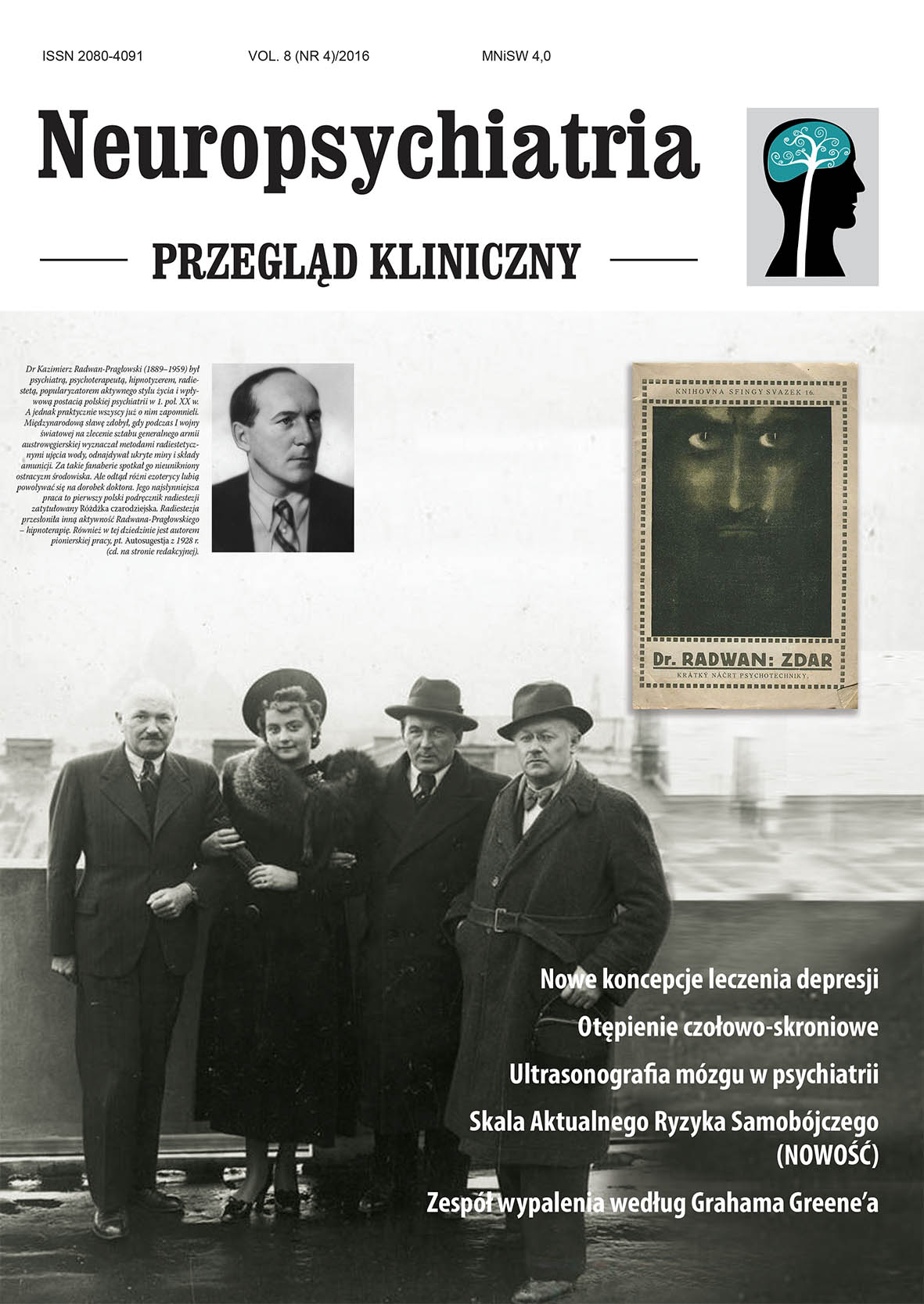Skala Aktualnego Ryzyka Samobójczego (SARS) Artykuł przeglądowy
##plugins.themes.bootstrap3.article.main##
Abstrakt
Skala Aktualnego Ryzyka Samobójczego (SARS) powstała, by wspomagać lekarzy psychiatrów podejmujących medyczne i prawne decyzje w trakcie hospitalizacji psychiatrycznych. Umożliwia ona ocenę ryzyka wystąpienia zachowań samobójczych na dwa sposoby: ilościowy (określony sumą punktów) oraz jakościowy (określony kryteriami wysokiego ryzyka). Ustalenie kryteriów wysokiego ryzyka wspiera decyzję o konieczności leczenia i zachodzi w dwóch przypadkach: gdy spełnione jest kryterium A (niezależnie lub łącznie z B, C i D) lub gdy występuje triada kryteriów B, C i D. SARS ma zadowalające parametry psychometryczne, którymi można się posługiwać w praktyce klinicznej (Alfa Cronbacha 0,82, kappa 0,78).
##plugins.themes.bootstrap3.article.details##

Utwór dostępny jest na licencji Creative Commons Uznanie autorstwa – Użycie niekomercyjne – Bez utworów zależnych 4.0 Międzynarodowe.
Copyright: © Medical Education sp. z o.o. License allowing third parties to copy and redistribute the material in any medium or format and to remix, transform, and build upon the material, provided the original work is properly cited and states its license.
Address reprint requests to: Medical Education, Marcin Kuźma (marcin.kuzma@mededu.pl)
Bibliografia
2. Kupfer DJ. DSM-5’s New Approach to Suicide Risk, Behavior. Huffpost Healthy Living [dostęp: 02.11.2015].
3. Oquendo MA, Baca-Garcia E. Suicidal behavior disorder as a diagnostic entity in the DSM-5 classification system: advantages outweigh limitations. World Psychiatry 2014; 13(2): 128-130.
4. WHO. World Health Organization. Suicide.
5. Nordentoft M. Prevention of suicide and attempted suicide in Denmark. Epidemiological studies of suicide and intervention studies in selected risk groups. Dan Med Bull 2007; 54 (4): 306-369.
6. Olfson M, Wall M, Wang S et al. Short-term Suicide Risk After Psychiatric Hospital Discharge. JAMA Psychiatry 2016; 73(11): 1119-1126.
7. Dazzi T, Gribble R, Wessely S, Fear NT. Does asking about suicide and related behaviours induce suicidal ideation? What is the evidence? Psychol Med 2014; 44(16): 3361-3363.
8. Gliatto MF, Rai AK. Evaluation and Treatment of Patients with Suicidal Ideation. Am Fam Physician 1999; 59(6): 1500-1506.
9. C-SSRS.
10. Patterson WM, Dohn HH, Bird J, Patterson GA. Evaluation of suicidal patients: the SAD PERSONS scale. Psychosomatics 1983; 24(4): 343-345, 348-349.
11. Chan MK, Bhatti H, Meader N et al. Predicting suicide following self-harm: systematic review of risk factors and risk scales. Br J Psychiatry 2016; 209(4): 277-283.
12. Cronbach LJ. Coefficient alpha and the internal structure of tests. Psychometrika 1951; 16: 297-334.
13. George D, Mallery P. SPSS for Windows step by step guide: A simple guide and reference. 11.0 update (4th ed). Allyn and Bacon, Boston 2003.
14. Landis JR, Koch GG. The measurement of observer agreement for categorical data. Biometrics 1977; 33(1): 159-174.
15. Stefansson J, Nordström P, Jokinen J. Suicide Intent Scale in the prediction of suicide. J Affect Disord 2012; 136(1-2): 167-171.

